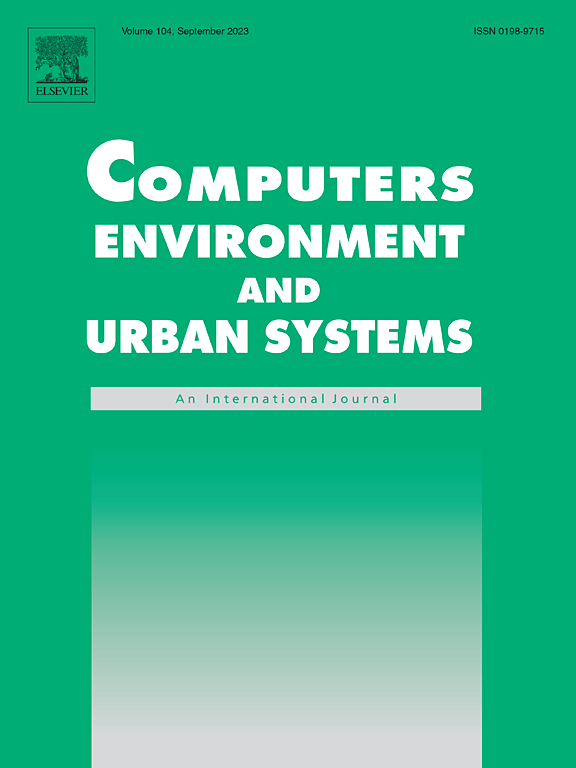公共设施的轮椅可及性及其延迟因素分析——以上海为例
IF 8.3
1区 地球科学
Q1 ENVIRONMENTAL STUDIES
Computers Environment and Urban Systems
Pub Date : 2025-08-04
DOI:10.1016/j.compenvurbsys.2025.102331
引用次数: 0
摘要
追求平等和可持续的社区是一种集体愿望,与联合国可持续发展目标相一致。公共交通系统作为中国轮椅使用者的主要出行方式,经常设置障碍,阻碍出行或延长出行时间。评估公共交通对轮椅使用者的空间可达性至关重要,以减轻他们的社会排斥,提高他们在社区中的参与度。然而,关于轮椅交通的可达性和导致出行时间延长的因素的研究却很少。本文以上海市为研究区,利用在线地图API,引入了一种轮椅无障碍公共交通路线规划算法,获取出行时间并识别延误因素,评估了轮椅使用者与一般人群在获取公共服务设施方面的空间可达性差异。主要发现包括:(1)73.9%的轮椅过境路线因轮椅设施不足而出现延误。(2)公园的可达性差距最大,在相同的时间阈值内,轮椅使用者的可达性仅为一般人群的45%。(3)步行段障碍物造成的延误时间最长,最常见的延误因素是缺乏可达的地铁站入口,机器学习模型的SHAP值对每个延误因素的影响提供了本地化的解释。研究结果揭示了上海轮椅交通可达性的差异,探讨了造成延误的因素,为上海的城市规划和基础设施改善提供了参考,并为其他城市的无障碍发展提供了参考。本文章由计算机程序翻译,如有差异,请以英文原文为准。
Wheelchair accessibility to public facilities via transits and analysis of delay factors—A case study of Shanghai, China
The pursuit of egalitarian and sustainable communities represents a collective aspiration and aligns with the United Nations’ Sustainable Development Goals. The public transit system, as the primary mode of mobility for wheelchair users in China, often imposes barriers that hinder travel or prolong travel times. It is essential to evaluate the spatial accessibility of public transit for wheelchair users to mitigate their social exclusion and enhance their participation within the community. However, there is a paucity of research on wheelchair transit accessibility and the factors contributing to prolonged travel times. This study introduces a wheelchair-accessible public transit route planning algorithm utilizing an online map API to acquire travel time and identify delay factors using the city of Shanghai as the study area, then evaluates spatial accessibility differences between wheelchair users and the general population in accessing public service facilities. Key findings include: (1) 73.9% of wheelchair transit routes encounter delays due to insufficient wheelchair facilities. (2) Parks show the largest accessibility gap, with wheelchair users’ accessibility at only 45% of that of the general population within the same time threshold. (3) Walking segment obstacles cause the longest delays, the most frequent delay factor is the lack of accessible metro station entrances, and SHAP values from the machine learning model furnish localized explanations regarding the impact of each delay factor. These findings reveal disparities in wheelchair transit accessibility and investigate factors causing delays, informing urban planning and infrastructure improvements in Shanghai and providing a reference for barrier-free development in other cities.
求助全文
通过发布文献求助,成功后即可免费获取论文全文。
去求助
来源期刊

Computers Environment and Urban Systems
Multiple-
CiteScore
13.30
自引率
7.40%
发文量
111
审稿时长
32 days
期刊介绍:
Computers, Environment and Urban Systemsis an interdisciplinary journal publishing cutting-edge and innovative computer-based research on environmental and urban systems, that privileges the geospatial perspective. The journal welcomes original high quality scholarship of a theoretical, applied or technological nature, and provides a stimulating presentation of perspectives, research developments, overviews of important new technologies and uses of major computational, information-based, and visualization innovations. Applied and theoretical contributions demonstrate the scope of computer-based analysis fostering a better understanding of environmental and urban systems, their spatial scope and their dynamics.
 求助内容:
求助内容: 应助结果提醒方式:
应助结果提醒方式:


